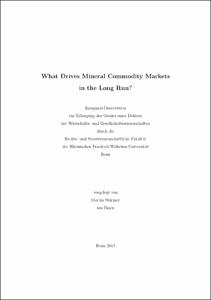What Drives Mineral Commodity Markets in the Long Run?

What Drives Mineral Commodity Markets in the Long Run?

| dc.contributor.advisor | von Hagen, Jürgen | |
| dc.contributor.author | Stürmer, Martin | |
| dc.date.accessioned | 2020-04-18T06:04:01Z | |
| dc.date.available | 2020-04-18T06:04:01Z | |
| dc.date.issued | 20.08.2013 | |
| dc.identifier.uri | https://hdl.handle.net/20.500.11811/5438 | |
| dc.description.abstract | This thesis analyzes the long-run development of mineral commodity markets both from a theoretical and an empirical perspective. The first chapter presents a model that replicates long-term trends in non-renewable resource markets, namely stable prices and exponentially increasing extraction, for which we present data from 1792 to 2010. We add an extractive sector to an endogenous growth model of expanding varieties and directed technological change. Extractive firms can draw down resource stocks through extraction, but also renew stocks through investment in new extraction technology. Our results suggest that technological change in extraction technologies offsets the increasing demand for non-renewable resources in industrializing countries like China in the long run. In the second chapter I provide long-term evidence on the dynamic effects of supply and demand shocks on mineral commodity prices. I explore a new annual data-set on prices and production of copper, lead, tin, zinc, and crude oil from 1840 to 2010. Long-term price fluctuations are mainly driven by persistent ''world output-driven demand shocks'' and ''other demand shocks''. Historical accounts of market events suggest that ''other demand shocks'' mainly capture changes in inventories. Due to oligopolistic industry structures, ''supply shocks'' exhibit some effects on the prices of tin and copper, but not on the prices of lead and zinc. Subsample results for crude oil indicate that during earlier periods ''supply shocks'' have been important drivers. My results suggest that prices will return to their stable or even declining trends in the long run. The third chapter deals with the long-term determinants of demand for mineral commodities. It is the first to provide empirical evidence covering the main periods of industrialization as far back as 1840. I extend the standard partial adjustment model to account for country-specific economic structures, technological change, and endogeneity. I find that the demand for aluminum and copper increases disproportionately high over the course of industrialization, while it decreases for lead, tin, and zinc. This suggests that the industrialization in China, for example, will cause aluminum and copper demand to rise to far higher levels than the demand for lead, tin, and zinc. The demand for all examined mineral commodities is highly inelastic with respect to price in the long run. According to theory, this causes incentives for conflict over these commodities and makes markets prone to speculation. All variables adjust slowly to equilibrium, which helps to explain the extended fluctuation in these markets. | en |
| dc.language.iso | eng | |
| dc.rights | In Copyright | |
| dc.rights.uri | http://rightsstatements.org/vocab/InC/1.0/ | |
| dc.subject | Rohstoffe | |
| dc.subject | Metalle | |
| dc.subject | Energie | |
| dc.subject | Rohstoffpreise | |
| dc.subject | Industrialisierung | |
| dc.subject | Rohstoffversorgung | |
| dc.subject | Erdöl | |
| dc.subject | Wachstum | |
| dc.subject | China | |
| dc.subject | Ressourcen | |
| dc.subject | Wirtschaftsgeschichte | |
| dc.subject | growth | |
| dc.subject | metals | |
| dc.subject | oil | |
| dc.subject | extraction technology | |
| dc.subject | price fluctuations | |
| dc.subject | demand | |
| dc.subject | supply | |
| dc.subject | price | |
| dc.subject | industrialization | |
| dc.subject | non-renewable resources | |
| dc.subject | economic history | |
| dc.subject.ddc | 330 Wirtschaft | |
| dc.title | What Drives Mineral Commodity Markets in the Long Run? | |
| dc.type | Dissertation oder Habilitation | |
| dc.publisher.name | Universitäts- und Landesbibliothek Bonn | |
| dc.publisher.location | Bonn | |
| dc.rights.accessRights | openAccess | |
| dc.identifier.urn | https://nbn-resolving.org/urn:nbn:de:hbz:5-33136 | |
| ulbbn.pubtype | Erstveröffentlichung | |
| ulbbnediss.affiliation.name | Rheinische Friedrich-Wilhelms-Universität Bonn | |
| ulbbnediss.affiliation.location | Bonn | |
| ulbbnediss.thesis.level | Dissertation | |
| ulbbnediss.dissID | 3313 | |
| ulbbnediss.date.accepted | 02.07.2013 | |
| ulbbnediss.fakultaet | Rechts- und Staatswissenschaftliche Fakultät | |
| dc.contributor.coReferee | Hellwig, Martin F. |
Dateien zu dieser Ressource
Das Dokument erscheint in:
-
E-Dissertationen (288)




